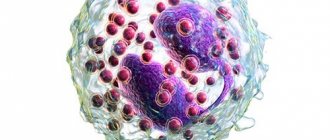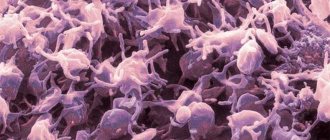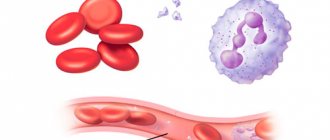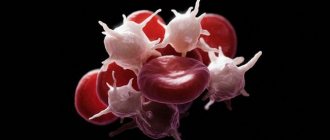What are platelets
Platelets are considered the formed elements of blood, which are colorless cells that do not contain nuclei, which are fragments of megakaryocytes produced in the bone marrow. They are often called blood plates. The main task of these cells is to close damaged blood vessels to stop bleeding, so their number can be called a vital indicator.
The cells live and perform their functions for about 7 days, after which they are destroyed in the spleen or liver . In the human body, platelets are constantly renewed, which ensures its normal existence and readiness for emergency situations. At the same time, only 2/3 of the total number of these cells constantly circulate in the bloodstream, while the rest are kept in the spleen as a reserve, used when necessary.
When damage to a vessel occurs, platelets are sent by the body to the site of the existing violation, where they begin to stick together to form a blood clot and close the hole. This process is called primary, or platelet, hemostasis.
What affects their number
The number of blood platelets depends on:
- Child's age. Newborns have more of them than infants older than a month and older children.
- Presence of diseases, as well as taking medications.
- Physical activity. For some time after it, the number of blood platelets becomes higher.
- Child nutrition. There are foods that can thin the blood, and some foods stimulate the formation of blood cells.
- Time of day, as well as time of year. During the day, fluctuations in platelet counts within 10% are observed.
In order for the blood test result to be reliable and the number of platelets in the analysis form to correspond to the real number of cells in the blood, it is important to follow these recommendations:
The child should not eat food before the blood is drawn. If a blood sample is taken from an infant, the interval between feeding and manipulation should be 2 hours. Before the analysis, the child should not have emotional or physical stress
It is also important to choose the right clothes for your child to avoid hypothermia. It is also not recommended to donate blood immediately after the child enters the clinic from the street.
Let him rest in the corridor for 10-15 minutes and calm down. If your child is already undergoing any treatment, be sure to tell the doctor before donating blood that you are taking medications, as they may affect the overall picture.
Normal platelet count in children's blood
The platelet rate in a blood test in a child and children under one year of age in most cases depends on his age.
| Age | Norm in *109 |
| Newborns up to 10 days | From 100 to 420 |
| From 10 days to 1 month | From 150 to 400 |
| From 1 to 6 months | From 160 to 400 |
| From 6 months to 1 year | From 180 to 400 |
| From 1 year to 4 years | From 160 to 400 |
| From 5 to 7 years | From 180 to 450 |
For healthy children, a blood test to determine platelet levels is recommended once a year. The number of studies can be increased in cases where the baby has blood pathologies, for example, a clotting disorder that depends on platelets.
The number of these blood cells can change not only as the child ages, but also in other situations, for example, when various pathologies or diseases appear. In this case, a decrease in indicators is called thrombocytopenia, and an increase (beyond normal) is called thrombocytosis.
An increase can be observed not only with natural physical changes occurring in the baby’s body, but also with various stressful situations, as well as with a number of diseases.
Thrombocytosis is quite dangerous, because in this condition clots (floating blood clots) begin to form in the blood, which can clog blood vessels and pose a threat to life.
How to treat?
To make a correct diagnosis, the doctor must order some tests. For example, the platelet rate in a 5-year-old child is 160-390*109/l; if the test results revealed a higher value, then the doctor will recommend performing the following procedures:
- at intervals of 3-5 days you need to take a blood test for platelets (3 times);
- conduct a quantitative study of C-reactive protein;
- Ultrasound of the pelvic and abdominal organs;
- take a general urine test;
- check serum iron and ferritin levels;
- consult a gynecologist and urologist.
If the baby has slightly elevated platelets (500), the baby does not have serious problems. This amount can be reduced without taking special medications.
Decreased platelet levels
The normal level of the element should not fall below the initial normal limit, but in some cases, even young children may experience thrombocytopenia. This occurs for various reasons, for example:
- With anemia of megaloblastic or aplastic type.
- In the presence of leukemia.
- With Fanconi syndrome, which is a hereditary predisposition to thrombocytopenia.
- In the presence of rickettsiosis or toxoplasmosis.
- When infected with malaria, rubella or measles.
- With DIC syndrome.
- If you have multiple allergies.
- With Werlhof's disease.
- With a lack of folic acid in the body.
- For hyperthyroidism caused by the presence of pathologies of the thyroid gland.
- For prolonged bleeding and trauma.
A decrease in platelet count in children of different ages is not so rare , since their body cannot yet fully resist various negative factors, but is very sensitive to them.
In premature infants, thrombocytopenia is observed in almost 60% of cases, as well as in low birth weight babies. The same phenomenon can be observed in case of asphyxia of the baby during childbirth or during intrauterine development, as well as in the presence of problems in the functioning of the immune system, in particular, in the formation of antibodies to platelets.
Thrombocytosis consequences and causes
A significant excess of plt in a blood test is called thrombocytosis. The disease is characterized by a greater than necessary number of anucleate cells in the blood stream, which leads to its viscosity and thickening. Thick blood is not able to circulate fully. In addition, formed particles with their own mass in the form of blood clots (thrombi) clog the passages in the capillaries and vessels of the circulatory system, which can lead to many problems in the functioning of various organs and systems of the growing body.
Depending on the cause of its occurrence, thrombocytosis can be:
- Primary. It occurs when platelet synthesis in the main hematopoietic organ is disrupted.
- Secondary. It manifests itself with the development of pathologies such as malignant tumors, infections of various etymologies, damage to the functioning of the circulatory and cardiovascular systems. In addition, it can occur due to a lack of iron, organ damage, as a result of taking certain medications, or during intense physical activity. And also after surgical interventions on the spleen or liver.
Increased platelet levels
This condition is called thrombocytosis, and in medicine it is divided into primary and secondary.
Primary thrombocytosis is a condition when the body has an abnormal process of producing blood platelets in the bone marrow due to disorders in its cells. This is usually due to the formation of tumors in the parent cells, which causes their pressure to increase, which leads to the production of more platelets. This condition is called essential thrombocytopenia, and it occurs with certain ailments, in particular with:
- Lymphoma,
- myeloid leukemia,
- Lymphogranulomatosis,
- Erythremia.
Secondary thrombocytosis is a condition caused by too active production of thrombopoietin, which stimulates the process of cell division and maturation. This violation occurs when:
- Carrying out surgical operations or receiving various injuries.
- Inflammatory processes.
- Getting infected.
- Osteomyelitis.
- Removal of the spleen.
- Tuberculosis.
- Prolonged and intense bleeding.
- Iron deficiency anemia.
- Kidney pathologies.
- Carrying out therapy with corticosteroids, especially Cortisone.
- Hemolysis, which is the accelerated destruction of red blood cells.
- The presence of autoimmune diseases.
How to take the test correctly and how to prepare?
As a rule, biomaterial from a finger is required for general analysis, although exceptions are possible when the sample is taken from a vein.
For the greatest reliability of the result, it is recommended to take the test on an empty stomach in the morning. In principle, you can undergo this procedure at other times of the day, but in this case, laboratories advise maintaining an interval after eating for at least 3-4 hours and avoiding eating fried and fatty foods that day.
On the eve of the test, it is recommended to avoid excessive physical activity and not drink alcoholic beverages. Immediately before the procedure, you need to calm down, avoid stress and not smoke for an hour before the test.
How to normalize platelet levels
Restoring normal values can be done both with the help of medications and by normalizing nutrition and following a certain diet. As a rule, hematologists resort to medications when treating children only in emergency cases, when platelet counts become critical and this condition threatens the baby’s life.
If there is a slight deviation from the norm or a temporary violation of the level, you can restore the normal state by adjusting the diet.
Diet for thrombocytopenia
To increase platelet levels, you should consume foods that stimulate the production of blood platelets, and exclude those that contribute to the inhibition of this process. It is recommended to include in the diet:
- Various types of cabbage.
- Buckwheat porridge.
- Nuts.
- Carrots and beets.
- Pomegranates and bananas.
- Dog-rose fruit.
- Decoction of nettle leaves.
- Rowan berries.
- Fresh herbs, especially parsley, dill and cilantro.
- Boiled meat, fish and liver.
- A variety of vitamins in large quantities, especially folic acid and vitamin B12.
In this case, you should exclude from the diet: seaweed, red grapes, cucumbers and cranberries, which help reduce blood clotting.
Diet for thrombocytosis
Here, too, normalization of nutrition can help increase platelet levels if its decrease is not critical. To do this, you need to include in your diet:
- Olive and flax oil.
- Fish fat.
- Tomatoes.
- Lemons.
- Sea buckthorn berries.
- Ginger.
- Green tea and special herbal mixtures.
- Garlic and onion.
In this case, you should avoid eating mangoes, bananas, pomegranates, nuts, rose hips and chokeberries, and lentils.
It is very important that the child consumes a lot of fresh fruits, berries and vegetables, as well as juices per day . But all juices should be only natural, freshly squeezed, without added sugar.
It is important to remember that eating any harmful foods leads to blocking the natural production of platelets, so their number in the blood gradually decreases, and this only complicates the situation.
Platelets are elevated: detailed breakdown of the analysis
Red blood platelets are divided into 5 main groups. In smears they are painted lilac or blue. The size of thromboplastins depends on age and functionality. Aging cells decrease in volume.
In a general analysis, when platelets are elevated, it is necessary to conduct studies of the number of each group:
- Young forms (the concentration of the total volume of thromboplastins is only 5%);
- Mature (90%);
- Old (4%);
- Degenerative (maximum up to 2%);
- Giant macroplatelets.
Basically, the mature forms of PLT do all the work. The mechanism of their operation depends on the activation of the blood clotting factor. It is important to note that coagulation occurs only in stationary physiological fluid, while aggregation occurs during its movement through the bloodstream.
To decipher the analysis in detail, a platelet distribution index is performed to understand the percentage of each group of platelets. There are situations when there are more degenerative or juvenile cells. Thus, the functionality of mature forms is significantly reduced and the efficiency of coagulation decreases. In such cases, the patient is referred for a coagulogram.
The platelet index (PDW), that is, the width of platelet distribution, precisely shows the state of cell populations and changes in their sizes. The analysis rate should be 15-17%. Modern hardware analyzers produce histograms that show functionality, volume during clot formation, and adhesive capabilities.
Thrombocytopenia in newborns and babies up to one year old
In babies under the age of one year, a decrease in platelet levels can manifest itself in a fairly acute form, which is not so rare. Often their number in the bloodstream decreases, but at the same time there is no decrease in cell production in the bone marrow, and sometimes, on the contrary, there is a slight increase in synthesis.
The baby's skin may develop bruises in this condition. Hemorrhages are also observed on the mucous membranes, and sometimes in the internal organs. Most often this is associated with certain types of serious diseases, such as measles or rubella.
Sometimes the reason for a decrease in platelets in a baby is the production of antibodies to them by the mother's immune system . As a result, the active breakdown of blood plates begins in the baby’s body. A child in this condition may begin to bleed, in some cases even threatening his life. A baby in such a situation may require emergency assistance in the form of a blood transfusion or platelet injection.
For young children, thrombocytopenia can pose a serious danger, since this condition often contributes to the onset of bleeding in internal organs, as well as significant blood loss when injured.
Treatment of thrombocytopenia in children of this age should take place exclusively in a hospital setting and under the strict supervision of a doctor.
Proper nutrition: preventing blood clots
If the increase in platelets is insignificant, then their level can be lowered with the help of diet and traditional recipes. It is important to remember that all methods of therapy must be agreed upon with a hematologist, since self-medication can lead to a deterioration in health. This is especially true for medicinal herbs, which, if chosen incorrectly, can increase the risk of thrombosis.
If deviations are observed in a baby, then, naturally, there is no need for him to change his diet. The mother must take care of this so that breast milk contains useful substances. Children and adults are recommended to adhere to the following rules of daily nutrition:
- Add blood thinning foods to your diet (olive oil, ginger root, sour berries and fruits, viburnum, beets, fish oil);
- Drink plenty of fluids (assuming that for every kilogram of weight you need to take 30 ml of water);
- Instead of coffee, drink tea, compotes, natural juices diluted with water 1:1;
- Onions and garlic are good antiplatelet agents; they can be consumed every day without fear (garlic cloves can dissolve already formed blood clots);
- You can take dietary supplements with magnesium, which prevents thromboplastin gluing;
- Avoid dehydration of the body, as this thickens the blood and narrows the blood vessels, which threatens the adhesion of blood clots to the walls of the blood network.
It's also worth knowing that there are foods that increase PLT levels. These include bananas, rose hips, pomegranates, walnuts, and lentils. Alcohol and tobacco also thicken body fluids. And hormonal drugs (for example, contraceptives or anti-inflammatory drugs), diuretics should be taken only as prescribed by a doctor if the patient has problems with the production of thromboplastins.
Traditional recipes also help lower platelet levels, but their choice should only be made by a hematologist. It is allowed to prepare the following composition for varicose veins: 100 grams of garlic and honey, mixed with 200 grams of onion and 50 grams of lemon. Grind the mixture with a blender and take a teaspoon three times a day. Taking the medicine may take a long time, but it will provide positive results.
It is important to remember that without treatment the disease will progress and cause complications. You need to contact a hematologist as soon as possible and start therapy.
Specifics of treatment
There are no medications to increase platelets; it is necessary to treat the pathology that caused their decrease.
If a child begins to bleed, he must be immediately hospitalized for emergency care.
In some cases, doctors consider it advisable to prescribe the following drugs:
- Corticosteroids - they affect the functioning of the adrenal glands and the production of platelets is stabilized. Among the most popular drugs are Prednisolone and Dexamethasone.
- Immunoglobulins - these injections are prescribed in the presence of an inflammatory process in the body. Drugs in this group strengthen local immunity, increase platelet production and promote their life expectancy.
- Serum that prevents the destruction of platelets. It is prescribed when other methods have no effect.
Leukocytes in men - the norm in the blood and other research methods
In addition, platelet levels can be influenced by introducing certain foods into the diet:
- walnuts;
- carrots;
- celery;
- spinach;
- almonds;
- olive oil;
- red fish;
- Atlantic herring.
It is necessary to exclude from the diet:
- watermelons;
- lingonberries and strawberries;
- cranberries and strawberries;
- tomato, lemon, orange and pineapple juices.
How to treat thrombocytopenia with folk remedies is described in the video:
Reasons for increased indicators
In case of a significant increase in the level of these cells, a disease occurs - thrombocytosis.
The disease is caused by disturbances in the functioning of the red bone marrow , which is responsible for the synthesis of these cells, or problems are located in the blood cells themselves.
The reasons are as follows:
inflammatory processes or infections;
iron deficiency or anemia;
disorders of the kidneys;
severe bleeding (possibly internal);
hemolysis (rapid destruction of red blood cells);
A high level increases coagulability , which means there is a risk of blood clots forming in the vessels, which is life-threatening. If they become clogged and burst, internal bleeding will occur, which will inevitably lead to damage to surrounding tissue. Possible stroke.











